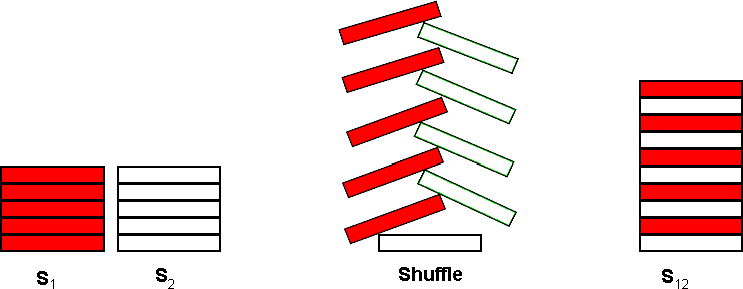poj 3087
来源:互联网 发布:linux修改用户组 编辑:程序博客网 时间:2024/06/05 05:08
Description
A common pastime for poker players at a poker table is to shuffle stacks of chips. Shuffling chips is performed by starting with two stacks of poker chips, S1 and S2, each stack containing C chips. Each stack may contain chips of several different colors.
The actual shuffle operation is performed by interleaving a chip from S1 with a chip from S2 as shown below for C = 5:

The single resultant stack, S12, contains 2 * C chips. The bottommost chip of S12 is the bottommost chip from S2. On top of that chip, is the bottommost chip from S1. The interleaving process continues taking the 2nd chip from the bottom of S2 and placing that on S12, followed by the 2nd chip from the bottom of S1 and so on until the topmost chip from S1 is placed on top of S12.
After the shuffle operation, S12 is split into 2 new stacks by taking the bottommost C chips from S12 to form a new S1 and the topmost C chips from S12 to form a new S2. The shuffle operation may then be repeated to form a new S12.
For this problem, you will write a program to determine if a particular resultant stack S12 can be formed by shuffling two stacks some number of times.
Input
The first line of input contains a single integer N, (1 ≤ N ≤ 1000) which is the number of datasets that follow.
Each dataset consists of four lines of input. The first line of a dataset specifies an integer C, (1 ≤ C ≤ 100) which is the number of chips in each initial stack (S1 and S2). The second line of each dataset specifies the colors of each of the C chips in stack S1, starting with the bottommost chip. The third line of each dataset specifies the colors of each of the C chips in stack S2 starting with the bottommost chip. Colors are expressed as a single uppercase letter (A through H). There are no blanks or separators between the chip colors. The fourth line of each dataset contains 2 * C uppercase letters (A through H), representing the colors of the desired result of the shuffling of S1 and S2 zero or more times. The bottommost chip’s color is specified first.
Output
Output for each dataset consists of a single line that displays the dataset number (1 though N), a space, and an integer value which is the minimum number of shuffle operations required to get the desired resultant stack. If the desired result can not be reached using the input for the dataset, display the value negative 1 (−1) for the number of shuffle operations.
Sample Input
24AHAHHAHAHHAAAAHH3CDECDEEEDDCC
Sample Output
1 22 -1
Source
Greater New York 2006
题目大意:
已知两堆牌s1和s2的初始状态, 其牌数均为c,按给定规则能将他们相互交叉组合成一堆牌s12,再将s12的最底下的c块牌归为s1,最顶的c块牌归为s2,依此循环下去。
现在输入s1和s2的初始状态 以及 预想的最终状态s12
问s1 s2经过多少次洗牌之后,最终能达到状态s12,若永远不可能相同,则输出"-1"。
思路:若s1和s2在洗牌后的状态,是前面洗牌时已经出现过的一个状态,且这个状态不是预想的状态S12,就说明无论怎样再洗牌都不可能达到S12了,因为这个洗牌操作已经陷入了一个“环”
如果状态没有重复过,则一直模拟洗牌,直至s12出现
#include<iostream>#include<algorithm>#include<cstdio>#include<math.h>#include<string.h>#include<queue>typedef long long ll;#define INF 0x3f3f3f3fusing namespace std;char s1[110],s2[110],s12[220];char t1[110],t2[110],t12[220]; ///保存原始的字符串 后面好比较。int main(){ int T,n,ans,flag,i,j,len,ca=1; scanf("%d",&T); while(T--) { flag=0; ans=0; scanf("%d",&n); getchar(); scanf("%s",s1); scanf("%s",s2); scanf("%s",s12); strcpy(t1,s1); strcpy(t2,s2); strcpy(t12,s12); while(1) { len=strlen(s1); for(i=0,j=0;j<len;i+=2,j++) ///模拟洗牌过程,s2在最下面,s2[0]即为s12[0];不要弄混了 { s12[i]=s2[j]; s12[i+1]=s1[j]; } ans++; if(strcmp(s12,t12)==0) { flag=1; break; } for(i=0;i<len;i++) ///重新分牌 s1[i]=s12[i]; for(i=len,j=0;i<2*len;i++) s2[j++]=s12[i]; if(strcmp(s1,t1)==0 && strcmp(s2,t2)==0) break; } if(flag==1) printf("%d %d\n",ca++,ans); else printf("%d -1\n",ca++); } return 0;}- POJ 3087
- poj 3087
- POJ 3087
- poj-3087
- poj 3087
- poj 3087
- 3087POJ
- poj--3087
- POJ 3087
- poj 3087
- POJ 3087
- POJ 3087
- POJ 3087
- poj 3087解题报告
- Poj 3087 (bfs)
- poj 3087 模拟
- poj 3087 模拟
- poj 3087 模拟题
- MyBatis学习:从JDBC到Mybatis
- vertica-修改表结构(涉及vertica底层的操作)
- listview 点击错乱
- Android在xml中设置点击事件不响应
- redis - Java操作
- poj 3087
- 222. Count Complete Tree Nodes
- [Java]ArrayList与LinkedList的模拟实现
- squirrel-sql通过phoenix-4.7.0连接windows中的hbase-1.1.3(一)
- flume 用户指南 - part 1
- Python3 函数
- 经典算法题03-猴子吃桃
- mybatis动态sql的书写
- 了解Context


